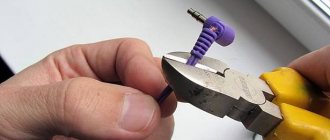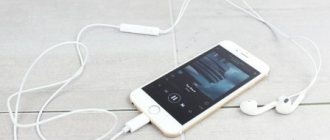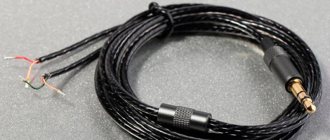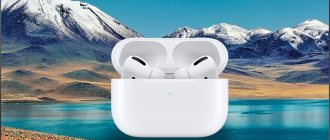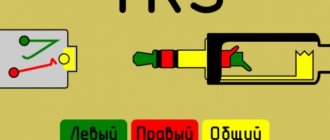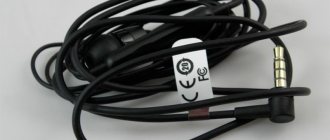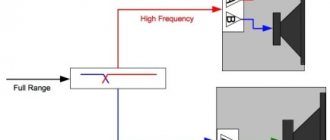Many users of smartphones, MP-3 players and other portable devices for playing music often experience their headphones breaking. This happens because thin wires are regularly subject to deformation due to twisting, rewinding or other bending that occurs every time the accessory is put into a pocket or bag. On expensive large headphones, you can replace the cable, as this is provided for by the design of the gadget, but this solution is not suitable for inexpensive accessories. However, there is no need to rush into buying new devices - there are several simple ways to fix headphones if the wire breaks. Most users can do the repair work themselves at home.
Identification of the rupture zone
To repair damaged headphones, you first need to find a break, and this can be done by probing or using a multimeter . Probing the cable to detect a breakdown is the easiest way. You need to connect the headphones to the sound source, start the music and begin to carefully bend the wire in the direction from the plug to the speakers, without missing a single centimeter. If in some place the music begins to be interrupted, a crackling sound or other noise appears - this is the place where the wire breaks.
Using a multimeter is a professional and more accurate way to detect cable damage. It is necessary to turn on the measuring device, set the sound diagnostic mode, and then connect the probes correctly: black to the COM connector, red to mA. Now you need to carefully make notches near the plug and the earphone itself, and then install the probes in them. If the device beeps, this means that the wire is intact, and the problem needs to be looked for elsewhere. If the multimeter is silent, you need to make a cut in the middle, and then check both halves of the cable one by one. Where the wire is intact, the device will beep. The tester is silent on the damaged part of the cable. In this area you also need to find the middle and make a cut again. In this way, you should check the cable until there remains a faulty section a couple of centimeters in size.
Important! The best way to reconnect damaged wires is to use a soldering iron. If the user does not have such a device or experience working with it, it is allowed to twist or connect the torn wires with solder or solder paste.
How to disassemble Earpods anyway?
Unlike the previous Earpods model (on the fourth iPhone), the second one is much better in quality. For example, the headset in the area of the microphone and volume control is protected both at the top and bottom from kinks by thickening. Opening this part of the wire is not difficult: just use a pick or something thin that can be pryed, for example, with a scalpel.
To partially open the funnel, remove the layer of glue using a scalpel. What we see after opening:
- paper membrane;
- postings;
- voice coil.
The case also contains one very important component - a magnet, which ensures sound quality.
Connecting wires by soldering
Once a damaged section of the cable has been identified, it is recommended to cut it out completely, rather than looking specifically for the break point. Next, you need to remove the outer insulation from the wire by about one and a half to two centimeters. Under it you will find several wires (from three to five, if the headphones have a microphone), which also need to be cleaned of protective insulation, if present. These steps will need to be repeated for the second piece of cable.
Important! Heat shrink tubing will be used to insulate the repaired cable. A piece of the required length should be placed on one of the cable sections before connecting them. Also, small pieces of heat-shrinkable tubing of a smaller diameter must be placed on each core.
Next, you need to firmly connect the wires of the same color, and then apply a layer of solder on top with a soldering iron. After the solder has cooled, you need to put pieces of heat shrink on the exposed wires and heat them with a hairdryer so that the tube shrinks and wraps them tightly. This is necessary so that the wires do not touch each other and do not cause a short circuit . Next, the insulated pieces of cable need to be assembled together, a piece of heat shrink of a larger diameter must be put on them and heated. This way they will not dangle, and the repair site itself will look beautiful.
Cable break near the plug
If one ear does not work, and diagnostics of the break point showed that the cable at the plug or the element itself is damaged, it is recommended to replace it with a new one. To do this, you first need to purchase another plug, and then cut off the old one along with a couple of centimeters of wire. Next, the new plug is unscrewed, and the insulation and braiding are removed from the cable by about 1.5-2 cm.
Important! The grounding conductor (usually yellow or two-colored) should be soldered to the copper sleeve, and the remaining two wires to the plug contacts. Solder correctly by first cleaning the contacts with fine sandpaper to ensure the best connection.
After completing the work, you need to assemble the plug, and it is important to make sure that the wires are not connected to each other. Otherwise, the headphones will not work. Read more about this in our article “how to repair a headphone plug.”
Break near the speaker
If, upon inspection of the accessories, it is discovered that they are torn at the speaker, you will need to disassemble the earphone to repair it. It is usually connected with latches, screws, or glue.
Advice! If the case is connected with glue, you need to clamp the device in a vice and apply pressure - the crack will go along the place of gluing.
The wire inside is almost always tied in a knot to prevent it from being pulled out during careless movement. It needs to be cut, the insulation removed, a safety knot made again and soldered to the contact with a soldering iron. After the repair, you need to reassemble the earphone. Other reasons why one earphone does not work are in our material.
Thermal tube instead of tape
Using tape is not entirely kosher. Therefore, I propose to improve the technology a little, again without a soldering iron.
You will have to buy a heat-shrinkable tube, also known as thermal casing, at an electronics store or hardware store. This is such a clever tube that can shrink in diameter by at least half when heated. This miracle costs about $0.1 - $0.5 per meter.
We will need two thermal tubes with different diameters: 1-2 mm for the first and 4-5 mm for the second.
We put pieces of thin thermal tube on our twists. We cut the pieces with one and a half margin.
Now you need to heat the thermo tube. Usually I did this with a soldering iron, but we agreed that I didn’t have one, and the story was about how to fix headphones without a soldering iron, so I had to get out.
The method turned out to be quite effective and the thermo-tubes shrank. You can also use any other heater or put them in boiling water like Easter eggs. In principle, people can do it with a regular hairdryer.
While the thermotube is still hot, you can further flatten it with your fingers, then it will slightly stick together inside.
This thermo-tube must subsequently be put on the joint and also compressed with the heat of the lamp. In general, you can squeeze lighters on fire, but you can accidentally set fire to excess.
I used a piece 8-10 cm long. To strengthen the structure, the end of the thermal tube was put directly on the elastic band of the connector.
Connecting wires without a soldering iron
If the user wants to do without a soldering iron to repair torn headphones, he can use solder paste, solder, or make a reliable twist.
Solder
You can fasten wires with solder without the help of a soldering iron. For this you need a small metal container. You need to put a small amount of solder in it and also add rosin. Now you should light the stove, place the dishes on it and melt its contents.
Next, you need to lower wires of the same color one by one into the solder and run them along a wooden block so that the substance is distributed evenly . You can perform the same steps and remove excess solder using a simple rag. Next, the wires are connected together, after which you need to wait until the material hardens. After this, the exposed sections of the wire must be insulated using heat shrink tubing or electrical tape.
In the same way, you can solder a wire if it breaks at the plug or near the earphone. In this case, you need to pour crushed solder and a little rosin onto a flat surface (contacts), and then heat it so that the substance melts. After this, the material is evenly distributed with any convenient object and the prepared wire with applied solder is applied to it.
Another convenient way to solder two wires together without a soldering iron is to use foil. The action diagram is as follows. It is necessary to remove the top braid from the cable, and then remove the insulation from the contacts (usually varnish with thread). Next, you need to cut strips from the foil along the width of the exposed wires. They are used to make grooves into which contacts twisted in pairs are placed separately. Solder and rosin are poured on top of them and distributed evenly along the surface. Now you need to wrap the foil tightly around the wire so that there are no gaps, and heat it until the solder melts. Next, the foil is removed, and the wires are tightly compressed with pliers, but this must be done carefully so as not to damage them. Excess solder can be easily removed with fine sandpaper.
Solder paste
Solder paste is more often used than regular solder to repair broken wires without a soldering iron. This process is faster and easier than working with solder and rosin.
On a note! It is inconvenient to work with a solid substance, but the paste is much easier to apply to the surface being treated. You can buy it at the store or make it yourself.
To repair headphone wires, you need to coat the exposed contacts with paste, connect them together and heat them over an open fire or in any other way. With this connection, soldering occurs deep between the wires, so its strength is significantly higher than when using solid solder.
Twist
Twisting the cable is the simplest solution. You need to take two identical wires from 2 to 4 cm long, connect them together and braid them, after which you need to put a heat-shrink tube on top or wrap electrical tape . The connection should be very strong, but do not tug the cable too much during operation. If everything is done correctly, the headphones will last for a long time.
How to seal a leak in a pipe: chemical methods (sealants)
The use of chemical methods for eliminating leaks uses various chemical compositions. Most often silicone based. Their use is due to high heat resistance (up to 350 degrees) and increased wear resistance. Fiberglass painting cloth is usually used as a reinforcing element.
The damage repair steps are as follows:
- A 2-3 mm thick sealant is applied to the cleaned damaged surface of the pipe, over which a painting cloth is rolled (back to back, layer to layer)
- On top of the first layer, another layer of sealant is applied and then reinforcing fabric, but with an overlap of 5 mm turns.
- The total number of layers must be at least 4
- The fabric is laid tightly, without “air” layers.
- The last layer of sealant is applied
- The treated section of the pipe must be left to dry. Depending on the type of sealant, this can take from several hours to several days.
Top articles: How to enter summer sporty and fit, without a single spot of fat on your body
Seal a hole in a metal or polymer pipe
In case of very minor damage to a straight section of a pipe, a bend or a threaded connection, you can use ordinary superglue (eg: “Minute”) and soda. When using this method, the main thing is to properly prepare the damaged area for applying the adhesive. The surface must be completely cleaned and degreased. To do this, use a file (or grinder) and any solvent.
- At least 3 layers of molar tissue are applied alternately to the damaged area, with a layer of baking soda applied to each layer. The last layer will be a layer of glue, which reacts with soda to form a dense waterproof shell.
- If the damage is a crack, then soda is driven inside and glue is applied on top. The chemical reaction will create a dense shell.
Features of headset restoration
Repairing a headset from a Samsung phone or another brand is a little more complicated than repairing regular headphones, because it is equipped with a microphone and a control button. There are usually four or five wires in a headset - one or two for microphone, two for headphones and ground. A control unit with a microphone is often installed where the cable branches to the left and right headphones. If a wire breakdown occurs above the area with the control unit, you will need to repair only one contact with or without a soldering iron. If the cable below the branching area is deformed, it is important not to make a mistake and connect the wires correctly.
Important! Usually the yellow (in some cases without insulation) cable is the grounding cable. Sometimes it can be wrapped over the microphone wire to reduce interference during a call. In any case, the cut wires are connected according to color.
Pinout diagrams by manufacturer
Apple audio pinout
- 1 - left
- 2 - right
- 3 - ground
- 4 - microphone
iPod Nano (4th, 5th Gen), iPhone (1st, 2nd, 3rd, 4th Gen), iPod Shuffle (3rd Gen), Cell Phone Connection iPhone headphone (handsfree)
1 - left 2 - right 3 - ground 4 - microphone
Lenovo Thinkpad Edge & X Series Notebook audio
Samsung audio pinouts
1 - left 2 - right 3 - ground 4 - microphone
Samsung i300, i330, i500, i700 handsfree/headset connector
Samsung OEM EHS64 Headset for Samsung Galaxy SIII GT-i9305 and some others
Samsung Series 9 Notebook headset (NP900X3D-A02DE)
Samsung SPH-a420, a580, a640, m220, m240, m300, m320, m330, Rant m540, Exclaim m550 SCH-R451C headset Samsung headset P/N: AEP010SLEB/STD
Samsung SPH-A880, SCH-U620, SCH-U540, SPH-M500, SCH-A950, SCH-A870, SCH-A930, SPH-A920, SPH-A940, SCH-A970, SPH-A900 BLADE, A900M, SCH- A990, SCH-U740 AEP204VBEB/STD Headset/Music
Plug repair
If the headphones are damaged near the plug, it was suggested above to cut off the old part and replace it with a new one. If you cannot purchase a new plug for some reason, you can repair the old element. To do this, you need to cut off the plug, stepping back two or three centimeters from it, since it is in this place that the wires can be broken. It should then be cut and cleaned if there is resin or other material inside. Next, you need to remove the remaining wires, after remembering how they are located.
Advice! To ensure that the cable at the exit point from the future plug does not bend or break, it is important to protect it. To do this, you will need a needle from a medical syringe, or rather, the cap itself. It is necessary to make a hole in the plastic nozzle to suit the size of the wire, and put a heat-shrinkable tube on top of it to make the structure look aesthetically pleasing.
Now you need to put heat shrink on the cable, then a syringe cap, after which the contacts should be soldered to the plug. To do this, you will need to first apply solder to them, and treat the contacts themselves with fine sandpaper. When soldering, the yellow wire is attached to the sleeve - this is grounding, and the remaining two - to the contacts. Now you need to connect the headphones to the sound source and make sure that the soldering is done correctly.
Next, you need to insert the cap into the plug, separate the wires inside so that they do not contact each other, and fill the entire space with glue. This will reliably insulate the wires and prevent short circuits. The adhesive substance must fill the entire volume, while preventing the formation of bubbles. After drying, you need to check again whether the headphones are working. Now you can put on the heat shrink tubing and heat it until it fits tightly around the cap. The renovation is complete.
Nature of damage
Before starting repairs, it is necessary to assess the damage and the feasibility of restoration. In some cases, such repairs will be expensive or difficult to fix.
The most common cord failure is a broken cable. Typically, a malfunction occurs in places with frequent kinks - near the connection plug or in a certain area along the entire length of the cable. A similar problem occurs with chargers that do not provide the ability to disconnect the USB cable.
Less commonly, cracks appear on the cable braid, resulting from prolonged use and gradual wear of the cable. Such damage does not affect the performance of the cable. In this case, ignoring the damage often leads to subsequent failure.
Prevention
The following simple rules will help prevent wire breaks in headphones.
- If you need to remove the headphone cable from the jack, you should grab the plug and pull it. Do not pull the wire as this may damage it.
- The headset should be kept in a safe place where it cannot be reached by children or animals. It should not be left on the floor where the accessory could be accidentally stepped on.
- When headphones are not in use, they should be disconnected from the sound source and removed from the head or ears. Otherwise, when trying to stand up or make any movement, they can get caught on something and accidentally damage them.
- It is recommended to store accessories rolled up, especially if the cable does not have a braided winding, but regular insulation. If the wire becomes kinked or tangled, it may be damaged.
- It is not recommended to keep the headset crumpled in a clothing pocket. A special clamp should be provided for the wires. An interesting solution would be an old bank card with an expired date. You can make notches on it for more durable winding of the wire. The headphones are also stored in a special case or case.
- Don't sleep with headphones on. During rest, they can be damaged due to negligence. In addition, listening to music while sleeping harms human hearing.
- When purchasing, you should choose more expensive headphones, preferably with a braided winding. It will not allow the wire to get tangled or knotted, which will extend its service life. It is also worth purchasing headphones with protection against breaking the wire near the plug. This is a special flexible part that prevents the cable from bending in this place.
- Some users wrap headphones around an MP-3 player. In this case, it is recommended to pull the plug out of the connector, otherwise the cable may break off at the bend.
- Before loading clothes into the wash, remove the headset from your pockets.
So, if the headphone cable has been damaged due to careless handling, do not throw away the accessories and purchase new ones. With a little time, you can repair the cable, regardless of where it is deformed - in the middle, near the plug or speaker. To restore the integrity of the wire, you can use a soldering iron, but if you don’t have such a tool, you can apply solder or solder paste without it. You can learn about other headphone malfunctions from our article “how to repair headphones with your own hands.”
Conclusion
The article details how to fix a broken Android charger cord. The instructions are relevant both for repairing a detachable USB cable and for chargers with a built-in cord. Before repairing, it is worth assessing the extent of the damage. In some cases, it may be better to replace the cable or the entire charger. Since modern chargers are complex and repairs cannot be done with just improvised means. And buying a specialized tool will cost more than buying a new charger.
Have you ever had to repair a charger cable? Share your opinion in the comments below the article.
In the High End League
The effect of changing cables was clearly visible on all three test models and, in general, it manifested itself in the same way: detail increased, and an expansion of the frequency range was audibly noted - the bass became deeper, and the high frequencies became lighter and cleaner. Additionally, music started to sound a little louder with the Atlas Zeno than with the original cables.
You can choose any connectors from Atlas Zeno. Here, for example, is a 4-pin XLR for connecting to a balanced amplifier
On the Audeze LCD-XC, Atlas Zeno's presence was most noticeable when listening to HiRes recordings. There was a feeling of greater integrity and harmony with a slight increase in resolution. For example, in the HiRes recording of Leonard Cohen’s 2014 Popular Problem (24bit/96kHz), the detail increased, the voice became even more velvety and deep. The recording of Carmen J. Bizet's suite performed by the London Royal Philharmonic Orchestra sounded even more precise and academic, and the dense guitar riffs of 30 Second to Mars, on the contrary, ceased to be overly intelligent and restrained, acquiring the proper expressiveness and assertiveness.
The new cables did not radically change the sound of the Audeze LCD-XC and did not make it a class higher. They became rather a worthy addition, a kind of cherry on an already delicious cake.
Test conditions
As a test system, we used a laptop with audio output via an ASIO driver on an XMOS USB DAC (PCM5102 chip), to which our laboratory headphone amplifier, assembled on powerful studio-grade chips, was connected. The main content was CD and HiRes quality, plus a few MP3 recordings just for contrast. The coverage of musical genres is as wide as possible: chamber and symphonic classics, jazz, rock of all types from the Beatles and Zeppelins to modern metal, electronic dance music, classical and pop vocals, ethnic music and various live recordings. In a word, everything that could possibly be in the collection of an experienced audiophile.
Special cable protectors
An effective and durable solution to problems with damaged charger cables is the use of so-called cable inserts. Unfortunately, this solution is quite expensive; a high-quality tip can cost up to 500 rubles. Cable protectors are designed in such a way that the most delicate part of the cable does not break and is carefully insulated.
Remember that if there is a short circuit, the cable is smoking or there is a distinct burning smell coming from it, then it must be replaced. The repair methods described above are suitable for cases where the insulation is damaged, but if problems are noted with the plug or the wiring melts, then using such a cable becomes simply unsafe.
Sonus Faber transformation
In the case of the Sonus Faber Pryma 01, the Atlas Zeno cables brought a very noticeable effect. With the supplied wires, the stage was narrow, all the sounds seemed to be collected “inside the head.” In addition, the bright midrange frequencies sometimes played too harshly, causing some discomfort to the ear. With the Atlas Zeno cable, they played more expressively, but most importantly, in a balanced way, becoming more loyal to those genres of music that did not sound at all with the standard cable.
Up to a certain point, Atlas Zeno wires are even thinner than the original ones, but how different the connectors are!
The mids of the sound became more comfortable and more textured, the bass sounded deeper and clearer. The high frequencies sounded cleaner, became clearer, more natural and airy, and the “stage” noticeably expanded. The voices of the musicians at the beginning of the track Silense from the HiRes version of the album Ottmar Liebert & Luna Negra – Up Close, 2008 (24bit/96kHz) became so realistic that I involuntarily shuddered in surprise, although I had already listened to the same composition with the included cable.
Returning to the stock cable finally convinced me that it was very different from the Atlas Zeno. The sound instantly became rough, dirty, the “stage” gathered into a point, the mids moved forward, becoming dry and flat, and the bass lost strength, becoming monotonous. Definitely, Sonus Faber Pryma 01 deserve better cables than what the manufacturer supplied them with. Even taking into account the fact that the price of the Atlas Zeno is half the price of the headphones themselves, such an upgrade seemed quite justified to me.
How to fix headphones if one ear (or both) is not working
In order for us to get the highest quality and super-creative plug that no one else has, we will need:
- Two .38 caliber shells. Suitable for Makarov pistol or similar. For example, I took brass sleeves for trauma (AKBS 9mm PA)
- Drill with drill bits (3, 3.5, 7 and 9.5mm)
- Hacksaw for metal
- Epoxy adhesive
- Syringe for 5 cubes
- Small vise
- Awl
- Sandpaper
- Soldering iron with a sharp tip (solder, flux and an aspirin tablet are welcome)
- A small board, approximately 30x30 mm and about 20 mm thick
We will make an L-shaped plug, because... it is better than straight (more reliable and more compact). So, let's go.
To begin with, we’ll make some small equipment to make it easier to work with the sleeves, so that you can safely clamp them in a vice without denting or scratching them. We take our piece of wood and drill a hole in it with a 9.5 mm drill, then make a cut with a hacksaw.
You should get something like this:
Now we can process our sleeves without fear of spoiling their chic appearance:
Since I had spent cartridges, there were dents on the primers from the firing pin. But we need everything to be beautiful, so we knock out both capsules using an awl, a hammer and straight hands:
Then we straighten one of them with light blows from the inside using something suitable (I took the shank from a broken drill of a suitable diameter).
To make it even more beautiful, you can sand it a little more with sandpaper:
Then we press the beautiful and even capsule into its original place:
If your cartridges are brand new, unfired, then knock out only the primer from one of them (you can throw it away immediately, it won’t be needed). We do not touch the second sleeve for now.
Then we clamp the sleeve without primer in a vice and drill out the bottom from the inside with a 7 mm drill. You need to drill so as to make the bottom of the sleeve as thin as possible. Those. the drill should come almost close to the hole from under the capsule (I left about 0.5 mm of margin).
Then carefully cut off the bottom to make a puck like this:
Now we take our sleeve with a primer and shorten it to 13 mm:
We carefully process the edges with sandpaper to obtain an even cut that is strictly perpendicular to the axis of the sleeve.
As a result, the two halves should fit perfectly into each other:
Now is the time to deal with the old plug and wires.
To begin with, very carefully, using a sharp knife, unscrew the old connector to remove all excess and leave only the plug itself with four contacts and soldered wires:
We remember, or better yet write down, where which wire was soldered. My HTC headphones (with microphone) had the following pinout:
We unsolder the old wires from the connector, strip the cable, tin the ends and shrink a piece of heat shrink (diameter 2.5 mm, length 21 mm).
To service wires in varnish insulation, it would be nice to take an aspirin tablet, but I didn’t have one, so I made do with regular rosin. If you work with aspirin, then know that the vapors of this nasty thing are terribly poisonous. You have been warned.
Drill a hole of suitable diameter in the wall of the sleeve. In my case, a 3 mm hole turned out to be ideal:
We thread the cable through the hole and solder the headphone and microphone wires (in strict accordance with the pinout!):
Well, the last step: using a syringe, measure out 0.5 ml of hardener and 5 ml of epoxy resin. Mix the ingredients together thoroughly.
Then, to expel all air bubbles, heat the mixture in a water bath to 80 degrees.
We fill our sleeve with the resulting composition to the brim, put everything in its place and, with the help of ingenuity and improvised devices, fix it all for at least 12 hours (or better yet for a day):
